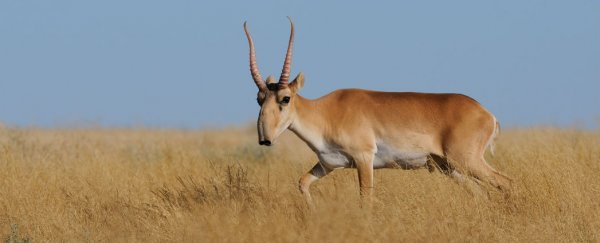Back in May, researchers watched as an entire herd of critically endangered saiga antelopes died in the space of just four days in Kazakhstan. Nearby herds also experienced spontaneous population crashes, with more than 134,000 dying within the space of just two weeks. By June, the die-off had stopped, just as abruptly and mysteriously as it had begun.
Now, researchers led by geoecologist Steffen Zuther from the conservation group, Altyn Dala Conservation Initiative, think they've found their first clues as to why more than half of Kazakhstan's saiga herd - which sat at around 257,000 individuals in 2014 - has disappeared. "The extent of this die-off, and the speed it had, by spreading throughout the whole calving herd and killing all the animals, this has not been observed for any other species," Zuther told Lisa Ghose at Live Science. "It's really unheard of."
Zuther and his colleagues suspect it all comes down to what are ordinarily harmless bacteria - Pasteurella and perhaps Clostridia - which hang out in saiga guts and only usually cause troubles in individuals with weak immune systems. But in this case, they've appeared to cause rapid and extensive bleeding in almost all of the Saigas' organs, and the close-knit groups of mothers and young calves ended up being the hardest hit, Live Science reports.
Caramel-hued with small, banded horns and a distinctive nose that looks like a trunk cut off at the base, saiga antelopes were once spread widely over the vast Eurasian steppe, which runs from Moldavia through Ukraine to Siberia, and parts of Hungary. But thanks to extensive hunting up till the end of the 18th century and more recently, poaching - their horns can fetch $150 each for use in traditional Chinese medicine - the populations have shrunk by as much as 95 percent in the past 15 years.
Now the dominant subspecies Saiga tatarica tatarica is only found in just one location in Russia, and three locations in Kazakhstan, and it's this limited range that's got conservationists so worried.
"Saigas play a critical role in the ecosystem of the arid grassland steppe, where the cold winters prevent fallen plant material from decomposing; the grazing of the dog-size, Gonzo-nosed antelopes helps to break down that organic matter, recycling nutrients in the ecosystem and preventing wildfires fuelled by too much leaf litter on the ground," Ghose writes for Live Science. Plus they also make a substantial meal for the larger predators in the area, such as wolves, which would be difficult to replace if the saiga populations disappeared.
This mass die-off has become something of a hallmark for the Kazakh saigas. Back in May 1988, 270,000 Saiga were wiped out in Kazakhstan, and again in May 2010, one of the populations lost 12,000 of its 26,000 individuals - both under much the same circumstances as we've seen this year. While researchers at the time put it down to an infectious disease called pasteurellosis, which attacks the lungs and intestines, they struggled to get out into the rugged and remote habitat to perform the extensive analysis needed to confirm this.
But the fact that both die-off events happened in May might be the biggest hint. As E.J. Milner-Gulland, a conservation biologist at Imperial College London and chair of Saiga Conservation Alliance, told Henry Nicholls at The Guardian, May is when the Saiga populations in Kazakhstan come together to give birth, and all that close-quarters living seems to make them particularly vulnerable to disease.
Another clue was that the mothers were dying off first, followed by the calves, so the researchers reasoned that the mothers were being infected by something either through what they ate or drank, and this was being transferred to the calves through their milk. A detailed analysis of the dead turned up nothing but harmless gut bacteria. "There is nothing so special about it. The question is why it developed so rapidly and spread to all the animals," Zuther told Ghose at Live Science.
Unfortunately, not much else is known at this stage, perhaps subtle environmental changes are making the populations more vulnerable to the poison excreted by these bacteria, Zuther says. And while mass die-offs aren't unsual for this species, or many other ungulates, when you've got so few left, you can't afford to lose this many at one time, as Milner-Gulland points out:
"If we understand the factors that contribute to these events, we may be able to mitigate or prevent them in the future. This is important because three of the four remaining populations of saiga are at such low levels that an event like this could wipe them out completely. Hunting is a serious problem. We need to get all these populations to a level that is actually resilient enough to cope with the natural mass mortalities that happen in the saiga antelope. Anti-poaching needs to be a top priority for the Russian and Kazakh governments."
